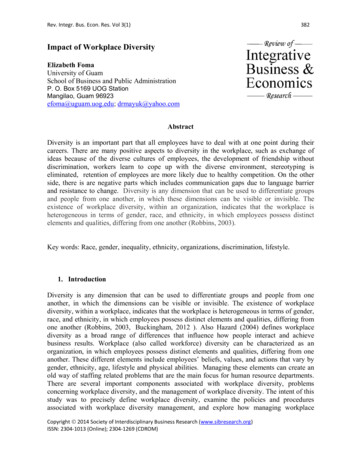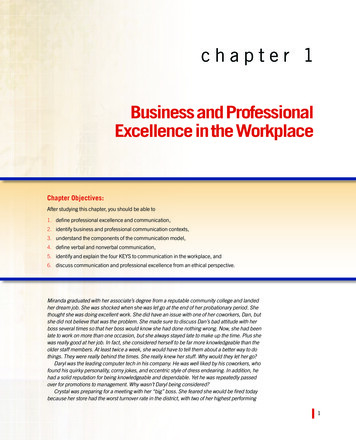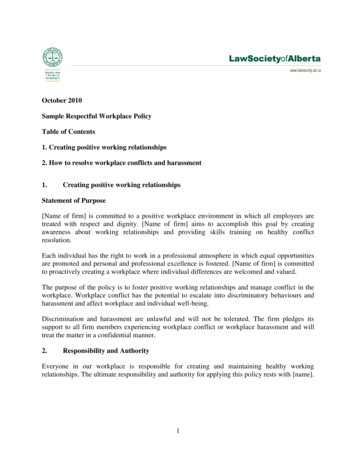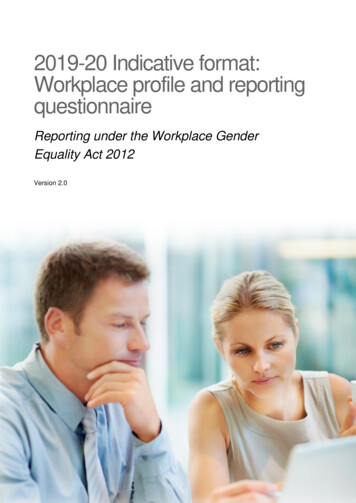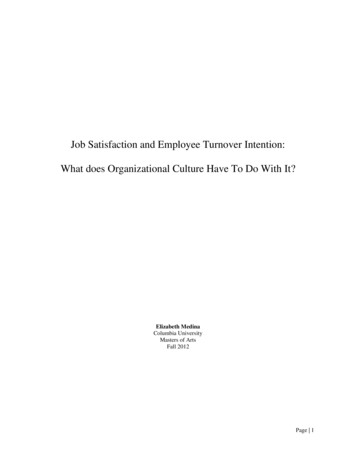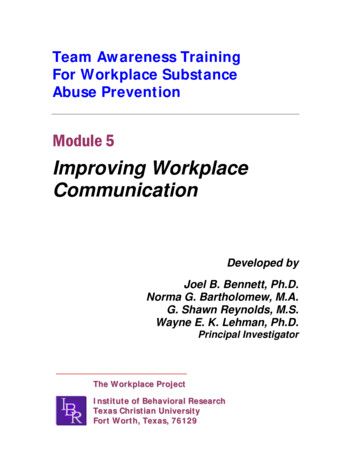
Transcription
Team Awareness TrainingFor Workplace SubstanceAbuse PreventionModule 5Improving WorkplaceCommunicationDeveloped byJoel B. Bennett, Ph.D.Norma G. Bartholomew, M.A.G. Shawn Reynolds, M.S.Wayne E. K. Lehman, Ph.D.Principal InvestigatorThe Workplace ProjectInstitute of Behavioral ResearchTexas Christian UniversityFort Worth, Texas, 76129
This manual was developed as part of a NIDA Grant (DA04390), Drug Use in theWorkplace: A Prevention Training Program, to the Institute of BehavioralResearch, Texas Christian University. The contents are solely the responsibilityof the developers and do not necessarily represent the official views of NIDA.This Team Awareness training module and all related data collection formsmay be used freely for personal, educational, research, and/or informationpurposes only. Permission is hereby granted to reproduce and distribute copiesof content material (except reprinted passages from copyrighted sources) fornonprofit educational and nonprofit library purposes, provided that copies aredistributed at or below costs and that credit for author, source, and copyrightare included on each copy. No part of any material may be copied, downloaded,stored in a retrieval system, or redistributed for any commercial purpose withoutthe expressed written permission of Texas Christian University.For more information, please contact:Institute of Behavioral ResearchTexas Christian UniversityP.O. Box 298740Fort Worth, TX, 76129(817) 257-7226(817) 257-7290 (FAX)Email: ibr@tcu.eduWeb site: www.ibr.tcu.edu Copyright 2002 TCU Institute of Behavioral Research, Fort Worth, Texas.All rights reserved.VISIT OUR WEB-SITE www.ibr.tcu.eduThe quotation from Ashleigh Brilliant (slide # 9) copied with permission;copyright by Ashleigh Brilliant; www.ashleighbrilliant.com).The purpose of this 3-year project was to refine, implement,and evaluate a team-based substance abuse preventionprogram for work settings. The program is designed toincrease employee awareness of issues relating toworkplace alcohol and other drug use and its consequences.Because these issues and consequences occur within anorganizational context, the training addresses specificfactors that aggravate employee substance use and preventeffective policy implementation.
OVERVIEW OF THE TCU DRUGS IN THE WORKPLACE PROJECTThe Drugs in the Workplace Project at Texas Christian University has studied the prevalence,antecedents, and consequences of employee substance use for over 12 years. Results have emphasizedthe importance of work environments, policies, and employee characteristics in understanding thepervasiveness and impacts of substance use in the workplace.In recognizing the changing social contexts in today’s workforce, Principal Investigator Dr. WayneLehman and researcher Dr. Joel Bennett spearheaded the development of two prevention programs.This manual contains material from the participatory "team-based" program and emphasizes theimpact of substance use problems on all team members in a work group (in terms of lostproductivity, having to cover for absent co-workers, and work-place safety). The approach promotesawareness of group dynamics that serve to condone or create tolerance for drinking or drug use in aworkgroup. Issues such as stress management, communication, risk identification, and how togently "nudge" a troubled co-worker to seek professional help are discussed. The second program isan enhanced "informational" training that primarily uses didactic presentations to familiarizeemployees with their workplace substance abuse policy, the effects of alcohol and various drugs ofabuse, and Employee Assistance Programs (EAP).Both programs have beenevaluated in two municipalworkforces -- a medium-sizedsuburban city in which workgroupsfromallcitydepartments (except uniformfire and police) were included,and departments that hadpreviously been identified as"at-risk" for substance abuseproblems from a larger urbancity.Work groups were randomlyassigned to receive either theteam-based or informationaltraining, or were assigned to ano-trainingcontrolgroup.Work groups were assessedtwo weeks before and afterthe trainings, and again at sixThe 6 components of Team oriented training are:months post-training. Overall,1) risk identification3) stress management5) communicationemployeeswhoattended2) policy awareness4) understanding tolerance6) peer referral skill trainingeither of the two trainingconditions showed improvements in important areas compared to employees in the control condition. Figure 1 summarizes theresults at 6-month follow-up for both cities. Five domains of outcomes were examined, including asupportive group climate, stress and coping, drinking norms, policy knowledge, and information aboutthe EAP. Arrows from the training condition to the outcome domain indicate a positive change. The boldarrows indicate more substantial change.
TEAM AWARENESS – TABLE OF CONTENTS TO ALL MODULESIn its original form, the Team Awareness program was delivered as two 4-hour (half-day)sessions, each session delivered a week apart. Session I consisted of Modules 1 and 2.Session II consisted of Modules 3 through 6. We used slightly different steps in differentwork sites and so the length of the modules here are longer, if facilitators choose to use allthe steps provided. These different options and an overview are explained in the manualtitled “Introduction and Facilitator Overview.” Each module has (1) an accompanyingmanual in Acrobat/PDF format and, (2) overheads and speaker notes as separate PDF files.ModuleManualOverheads/Speaker df(5) Improving -notes.pdf(6) Encouragement: TheNUDGE e6(casestudies)ho-notes.pdfIntroduction & FacilitatorOverviewSession 1(1) Relevance to you andyour work group:Orientation and RiskIdentification(2) Team Ownership ofPolicy: The Risks &Strengths GameSession 2(3) Reducing Stigma &Tolerance and IncreasingResponsiveness(4) Work Stress, ProblemSolving, and SubstanceUse
1Module 5Improving WorkplaceCommunicationParticipants will: Identify norms and responsibilities in workplacecommunication Identify and reduce blocks to effective listening Understand role of informal communication (thegrapevine) in the work settingFacilitator Overview and Session Outline: The following page (Page 2) shows an outline of the differentsteps in this module. As with other modules in this program, we wanted to givedifferent options or different tools for delivering this module. Step 1 is optional and may depend on whether you have conveyedthis information in other modules. For example, Module 1(Relevance) includes a brief component on communication, entitled“Personal Exercise # 3: “Finding Your Voice” (located on p.26 of theModule 1 trainer manual). You may refer back to this whenintroducing this module.Note. This module was delivered differently in the two experimental trialsin two different worksites. Steps 1, 2, and 3 were delivered in Site 1.Steps 2, 3, and 4 were used in Site 2. This was because Site 2 placedmore emphasis on the importance of skills-based listening andestablishing communication. See Instructors Manual for fullexplanation.Team Awareness: Improving Workplace CommunicationObjectives
2OutlineFollowing an introduction, this “Communication” module has four core steps.You have three TOOLS [ # ] to help involve participants.Which stepsdo youuse?1. Mini-lecture/discussion on communication norms andresponsibilities (Overheads # 2 through # 5)*a. Introductionb. Communication responsibilities/rules in different settingsc. Summary PointsYou may be able toskip all or part of Step1 if participants arefamiliar with theseconcepts.Alternatively, thegroup may haveexpressed anxieties,doubts, or concernsabout their roles andresponsibilities in peerreferral. If so, Step 1should be helpful inhelping participantsexplore theseconcerns.You may also launchdirectly into Steps 3and 4, which are moreinteractive, and thenfollow-up with Step 2to illustrate theimportance of usingguidelines whencommunicating.2. Seven guidelines for effective communication (Overhead # 6 and #7;Handout # 1)*#Tool 1a. Concerns and anxieties about communicatingb. How communication is involved in all previous modulesc. Seven ideas3. Grapevine communication exercise (Overhead # 8)#Tool 2a.b.c.d.Grapevine activityFacilitated discussionFlipchart of Benefits and DrawbacksConcluding Points4. Really Listening Exercise (Overhead#9 through # 11; Handout #2)#Tool 3a.b.c.d.Listening Do’s and Don’tsReally Listening Group ExerciseDiscussionConcluding Points*NOTE. The 7guidelines used inStep 2 arefundamental to theNUDGE model, whichis presented in thefollowing Module 6.Texas Christian University – Workplace Project at IBR (www.ibr.tcu.edu)
3Module 5Improving WorkplaceCommunicationParticipants will: Identify norms and responsibilities in workplacecommunication Identify and reduce blocks to effective listening Understand role of informal communication (thegrapevine) in the work settingStepOPTIONObjectivesSegment NameTime*1Mini-lecture oncommunication15 minutes2Seven Guidelines10 minutes3Grapevine Communication25 minutes4Really Listening Exercise25 minutesModule Length40 to 75 min.*Note. In the field tests of Module 5, we used different steps atdifferent times. You may be able to launch directly into Step 2depending upon how much you have reviewed the topic ofcommunication in previous modules. Communication is introduced inModule 1 (Step 6, Personal Exercise 3, Overheads 30/31/32) andunderlies the purpose of the entire Team Awareness training.Facilitators may choose to begin the Module with Overhead # 6 (p. 10]which provides a review of how communication has been part of allprevious modules.Team Awareness: Improving Workplace CommunicationSessionStructure
4MaterialsFacilitatorMaterials andPreparation Flip Chart or chalkboard Overhead or LCD projector and screen Markers or chalk Pens or Pencils for participants Slides or handout of slides for participants to follow A water soluble or erasable pen for overheads Handout materials (see below)Prepare before class Review all overheads and/or flipchart statements. Handouts - Have available or make copies for each participant:1. Seven Guidelines for Effective Communication (Overhead #13]2. Instructions for Really Listening Exercise (Overhead #14) Option: Create a handout from Overhead #11.Slides/OverheadsAll slides and overheads are available on the PDF companionversion of this manual (see "Module5(Communication)ho.pdf").There are a total of 12 overheads. The two handouts follow theOverheads (Overheads #14 and #15).Texas Christian University – Workplace Project at IBR (www.ibr.tcu.edu)
5Step 1Mini-lecture: Communicationnorms and responsibilities (OPTION)Includesa.b.c.d.15the following components:IntroductionCommunication responsibilities/rules in different settingsSummary PointsSeven Guidelines for effective communicationRationale (for the facilitator)Workers often are hesitant to come forward with their concernsabout co-worker substance abuse or other co-worker problems thatmay interfere with workplace productivity and cohesion. In manycases, this hesitancy may reflect a lack of basic assertiveness skillsand an uncertainty and anxiety about communicationresponsibilities inherent in work settings. This module allowsparticipants to (1) explore issues of personal responsibility invarious workplace communication situations and (2) to review andpractice skills that contribute to responsible and effectivecommunication. This module also serves as an introduction toModule 6 that provides more guided review and skills practice forpeer referral.Session Purpose -- ShowOverhead 2: Introduce theoverall topic and purpose.(You may use your ownwords, but cover the threemain ideas in the overhead).Explain that “norms”means social rules or whatis expected to be the“normal” or routine waysthat people agree on how tocommunicate with each other.RELEVANCEWORKPLACE COMMUNICATIONOverhead 2PURPOSE OF SESSION Identify norms and responsibilities inworkplace communication Identify and reduce blocks to effective listening Understand role of informal communication(the grapevine) in the work setting2Explain that communication norms and responsibilities go together.For example, we may only communicate what we think is normal tocommunicate because it is what we think is expected. The questionis who are we responsible to when we choose to communicate or notcommunicate? Also, do we withhold information because it mayhurt the group? Do we share information because it may help us?Team Awareness: Improving Workplace CommunicationPurpose
6Step 1 continued A. Introduction to Mini-lectureIntroduce the topic of workplace communication. You may useOverhead 3 #. Include some of the following points:WHY COMMUNICATION?Overhead 3WhyCommunicate We cannot not communicate Most of us spend about 70% of our timeactively communicating Effective communication can help reducesafety and behavior risk problems Concerns about how to talk to coworkerswho may have problems that need help1. One of the most important things we do at work is communicate witheach other. It’s been said that “we cannot not communicate.”Whether with words, gestures, body language, or even silence – weare always communicating.2. At work, most of us spend about 70% of our time activelycommunicating. We communicate face-to-face or on thetelephone; we communicate via computers, faxes, or radios; we readand write; we handle requests, we process paperwork, we respondto service calls, we deal with customers. Communication is theessential function of any workplace.EmphasizePoint 4:3. As you might imagine, communication plays an important role inthe issues we are covering in this training. In particular,effective team-based communication can help buffer many of thesafety, productivity, and morale problems caused by co-workersubstance use and abuse or other problems.4. We’ve included this section on workplace communication to helpaddress some of the interpersonal (person-to-person) issues thatworkers have told us concern them about confronting orreporting an impaired co-worker. These issues include concernsabout personal responsibility, personal safety, workplacecommunication networks, and the most effective communicationstrategies and techniques to use. These are the topics we willaddress today.Texas Christian University – Workplace Project at IBR (www.ibr.tcu.edu)
7Step 1 continued B. Communication responsibilities/rules in different settingsLead a discussion on personal communication responsibilitiesin the workplace. Use some of the following points:1. In all walks of life, we face different communication settings.2. All settings have “rules” or guidelines about the howcommunication is expected to happen, what can be said, howit can be said, and who can say it.3. These rules about how we should behave in communicationsettings may be formal (such as the parliamentary rulesobserved in city council meetings) or informal and traditional(such as communication in families or among friends).Make three columns on a piece of flip chart paper or useOverhead #4. Label one column as A FRIEND’S HOUSE,another as A COURTROOM TRIAL, and the third as A MOVIETHEATRE. Use the columns to list participant’s contributions asyou lead a discussion on rules in different settings. Encouragediscussion and prompt with the following questions.SAY: Let’s consider someof the rules orguidelines that mightapply in each of thesedifferentcommunicationsettings. I’ll promptyou with a fewquestions and we’llanswer them for eachof the three situations: COMMUNICATION SETTINGSOverhead 4Friend’s House4Courtroom TrialMovie Theater “Formal” or “Informal” Are YOU allowed to speak ? Who is allowed to speak? When should you speak? What are “rules” for speaking? What responsibilities?First off, how would you describe each of these settings – as “formal”or “informal”? How would you describe a friend’s house? Acourtroom? A movie house?Who is allowed to speak? At a friend’s house? The courtroom? Themovie theatre? Who or what governs who is allowed to speak? At a friend’s house?Courtroom? Theatre? How about how you are allowed to speak – what are the rules? At afriend’s? Courtroom? Movie? When can you speak in each setting? At a friend’s? A courtroom? Amovie? What responsibilities would you have in each communication setting?What responsibilities at a friend’s? A courtroom? A theatre?Team Awareness: Improving Workplace CommunicationSettingsInvite somediscussion:
8Step 1 continued Review the lists and compare the differences in communicationsettings.Explain: “As we can quickly see, there are a variety of communicationrules and guidelines based on the setting one is in. Most of us wouldn’tvisit a friend and then wait for his/her permission before speaking, justas most of us wouldn’t go into a courtroom and sit there telling jokesand chewing the fat in a loud voice.”Label a piece of flip chart paper or an area of an erasable board asJOB/WORKPLACE and use it to list participant’s contributions.Overhead 5ResponsibilityShow Overhead # 5 and Explain: “As mentioned earlier, the workplaceis an important communication setting. Like all communicationsettings it, too, has rules and guidelines. Of special importance inworkplace settings are communication responsibilities. Let’s considersome communication guidelines we may find in a workplace setting:” InviteResponse: How would you describe theworkplace setting – as “formal” or“informal”?COMMUNICATION RESPONSIBILITYCOMMUNICATION AND RESPONSIBILITYWho is allowed to speak in theworkplace? Communication is the essential function of anyworkplace. Effective, team-based communication buffersWho or what governs who isallowed to speak in the workplace?stress and improves productivity. Policies often state that workers havecommunication responsibilities regardingHow about how you are allowed tospeak – what are the rules?safety, problem-solving, and substance abuse. Effective communication strategies can helpworkers act on their responsibilities. When should you speak up atwork? What responsibilities do you have in a workplace communication setting?5C. Summary Points. Summarize by asking and discussing thefollowing question. Use flip chart or erasable board to listparticipants’ points:Ask: “Based on what you’ve already learned in this training about yourworkplace substance abuse policy, what communication responsibilitiesdo you have concerning problems in your work team?”Thank participants for their contributions. Summarize thediscussion and conclude with the following key points:1. We’ve listed a descriptive list of guidelines in differentcommunication settings – some formal and some informal.Texas Christian University – Workplace Project at IBR (www.ibr.tcu.edu)
9Step 1 continued 2. The workplace is a unique communication setting, with its ownset of guidelines and responsibilities. As mentioned earlier, thevery life of any organization depends on communication. Inhealthy and productive organizations, communication is gearedtoward the actual work process, as well as information sharing,problem solving, and heading off potential problems before they taketheir toll.3. In keeping with your policy, there are specific communicationresponsibilities each worker has concerning safety issues, impairedco-workers, or suspicions of co-worker impairment.4. Let’s look next at some general ideas about communication strategiesfor addressing these responsibilities.Link back toModule 2 (Policy) Step 2Seven guidelines for effectivecommunication10Include the following components:a. Concerns and anxieties about communicatingb. How communication is involved in previous modules (optional)c. Seven ideasA. Concerns and anxieties about communicatingBegin by asking participants to make a list of concerns oranxieties workers may have about exercising their responsibilityto communicate about an impaired co-worker or policy violations.Prompt with the following questions and allow some time fordiscussion (you may flipchart responses). When you think about actually talking with a supervisor ormanager about an impaired co-worker or policy violation, whatconcerns come to mind?When you think about confronting a co-worker about his/herimpairment or a policy violation, what concerns come to mind?Team Awareness: Improving Workplace CommunicationFlipchartoptional
10Step 2 continued Explain: “The concerns you have listed are valid ones, and they areconcerns that any reasonable person would feel in similarcircumstances. It’s difficult to think about “squealing” on a coworker, even when it is one’s responsibility, and even when we areaware of the serious health, safety, and productivity involved.Likewise, it’s always difficult to give people bad news. Confrontingsomeone who has a problem, even when our sincerest wish is toencourage that person to get help, is never easy.”Allayconcerns:Explain: “What we have to offer you today is not a magic bullet thatwill make this responsibility any easier for you. However, we do havesome general guidelines for dealing with these situations that canhelp you communicate fairly, honestly, and responsibly.”B. How communication is involved in previous modules (optional).Note. Overhead #6 provides a review of all the previous components andhelps to show how communication has been part of the training. Thisoverhead takes two minutes to display and may help some participants tounderstand better the purpose of Modules 5 and 6. It provides an overallcontext for the peer-referral aspects of the communication training.Show Overhead # 6.Remember that thepurpose of this training is“to improvecommunication in orderto reduce risks.” As aquick review, this slideshows how communicationis central to everything wehave been discussing.Overhead 6ReviewTeam-workRelevanceStrengthsRisksGetting HelpTolerancePolicyGetting CaughtStress &Problem Solving COMMUNICATIONModule 1 described howcommunication is relevant todealing with stress, providing service, and improving teamwork. Module 2 described the importance of knowing policy and communicatingwith others during the Risks and Strengths board game. Communication isinvolved in getting help as opposed to getting caught. Module 3 described tolerance for problems as a group process. One way oftolerating a problem is to not communicate about it. Module 4 – on stress – discussed the importance of social support and groupproblem solving as a healthy coping style. In addition, if you have difficultytalking about problems, the EAP is there to listen.Link allModules ServiceStress5Texas Christian University – Workplace Project at IBR (www.ibr.tcu.edu)
11Step 2 continued C. Seven Guidelines for Effective CommunicationDistribute handout Seven Guidelines for Effective Communication.Review Overhead # 7 and discuss each point below. Provideexamples and model appropriate nonverbal signals such as eyecontact, level tone of voice, emotional neutrality, and active listening.Explain: “If you suspect co-worker impairment or other violationsof policy, you are faced with several choices – do nothing, talk to asupervisor or manager, or talk to your co-worker about gettinghelp. Complaining to other co-workers or engaging in gossip maymake you feel better, but it won’t solve the problem.And that’s a key point. If you suspect violations or have concerns,problem solving communication is the kind to focus on.DistributeHandout 1 7 Guidelines#Tool 1Let’s review some key ideas for effective, problem solving communication:”1. Think about what you want to say. Before bringing up the issue,give it some consideration. Think about what you know, what yoususpect, what you are concerned about. Make notes. Have someidea of what you want to have happen as result of the meeting.2. Make your move. Request a meeting to discuss the issue. If youdecide to talk with a supervisor or manager, ask for anappointment. If you areSeven Guidelines for Effective Communicationcomfortable talking with theco-worker, ask him or her toTHINK ABOUT WHAT YOU WANT TO SAYmeet with you.MAKE YOUR MOVE3. Get right to the point.When we are anxious ornervous, we may talk arounda subject. This dilutes youreffectiveness when the mainpoint finally arrives.GET RIGHT TO THE POINTUSE GOOD COMMUNICATION SKILLSOverhead 77 GuidelinesAsk volunteer (s)to read outloud; and readpoints alongwithparticipantsMAKE A CLEAR REQUESTROLL WITH RESISTANCEEND ON A POSITIVE NOTE74. Practice good communication. Use I-Messages and listeningskills. I-Messages are non-blaming and non-agressive ways ofpresenting ideas, feelings, and concerns. Listening creates asupportive atmosphere.5. Make a clear statement about what you want to see happen. Ifyou are reporting to a supervisor, these might be a request foraction. If talking with a co-worker, make a clear request that thebehavior stop or that help be sought.Team Awareness: Improving Workplace CommunicationNote. Theseguidelines may beskipped here andused in Module 6or—for emphasis—may be repeated inboth modules.
12Step 2 continued 6. Roll with resistance. Supervisors may not want to hear about theproblem or may downplay it. Co-workers may become angry or denythe problem. These are normal defensive reactions to hearing thingswe don’t like as human beings. Listening respectfully and using a“broken record” can help dissipate strong feelings and make sure thatyour clear request for action is taken seriously.7. End on a positive note. Thank the person for their willingness tolisten. State your belief that the supervisor or co-worker can and willhandle the problem.Step 325Grapevine communicationexerciseIncludes the following components:Project a funattitude! Mentionthis is like a gamewe used to playin gradeschool.a.b.c.d.Grapevine activityFacilitated discussionFlipchart of Benefits and DrawbacksConcluding PointsA. Grapevine activity/Instructions. Without advance discussion, tellparticipants that they will now take part in an activity that deals withworkplace communication. Lead the activity using the following guidelines:1. Ask 5 or 6 volunteers to leave the room. The rest of theparticipants act as observers.#Tool 2TIP! Do not showoverhead # 8 untilall the last personhears the message.2. Explain to the volunteers that they will be called back into theroom one-at-a-time to receive a message, which they must thenpass on to the next person.3. Call the first volunteer back into the room, and read the messagealoud (see Overhead # 8). It is then passed on from memory.4. Call the second person back into the room to hear the messagefrom the first person. Repeat the process until the last personhears the message.Texas Christian University – Workplace Project at IBR (www.ibr.tcu.edu)
13Step 3 continued 5.Ask the last person to say the message aloud, as he/sheunderstood it.6.Show overhead (#10) of original message and read it aloud.B. Facilitated Discussion.Have participants return to their chairs, and ask them for feedbackon what happened using a flip chart to record their answers.Specifically, use these discussion questions:1. Which parts of themessage got distorted,omitted, or changed?I c an n o t w ait to re p o rt th is acc id e n t to th e p o l i ce .I m u st g e t to th e h o sp i tal as so o n as p ossib le . T h ed e l iv e ry tru ck w as h e ad in g so u th an d tu rn e d rig h tat th e in te rse c tio n ju st w h e n th e sp o rts car th atw as h e ad in g n o rth atte m p te d to tu rn le ft. W h e n th eysaw th at th e y w e re tu rn in g in to th e sam e l an e , th e yb o th h o n k e d th e i r h o rn s, b u t co n tin u e d to tu rnw ith o u t sl ow in g do w n . In fac t, I th in k th e sp o rtscar ac tu al ly sp e d u p ju st b e fo re th e c rash .2. How did this happen?3. In what ways does thisexercise remind you ofthe office “grapevine’?4. What does it say about“grapevine”communication?10Prime participants for a discussion of the benefits and drawbacks ofgrapevine with the following points.1.The obvious purpose of this activity has been to draw your attentionto problems inherent in “grapevine” communication in the workplace.2.All workplaces have formal and informal communication networks.Formal networks are usually business and work related. Informalnetworks often still pertain to work, but also involve personalopinions, feelings, and ideas. Gossip, rumor, and vendettas can alsoget caught up in the grapevine.3.Despite its problems, the “grapevine” is an important part of anysocial communication system.4.We all “get from” and “give to” the grapevine. That is, we takeinformation off of it, and we put information on it.Team Awareness: Improving Workplace CommunicationOverhead 8Accident Report
14Step 3 continued C. Benefits and Drawbacks of Grapevine.Ask: “What are the BENEFITS of grapevine communication andwhat are the DRAWBACKS?List participant responses on flipchart and discussBENEFITSDiscuss andemphasizePoint 4.DRAWBACKSLead a brief discussion on issues of substance abuse policy and thegrapevine. Include some of the following discussion questions:1. In weighing the benefits and drawbacks of the grapevine, what’s thebest advice we can follow?2. What is the craziest thing you ever heard off the grapevine thatturned out to be completely false?3. What responsibilities do we have when it comes to grapevinecommunication?4. When it comes to
1. Seven Guidelines for Effective Communication (Overhead #13] 2. Instructions for Really Listening Exercise (Overhead #14) Option: Create a handout from Overhead #11. Slides/Overheads All slides and overheads are available on the PDF companion version of this manual (see "Module5(Communication)ho.
